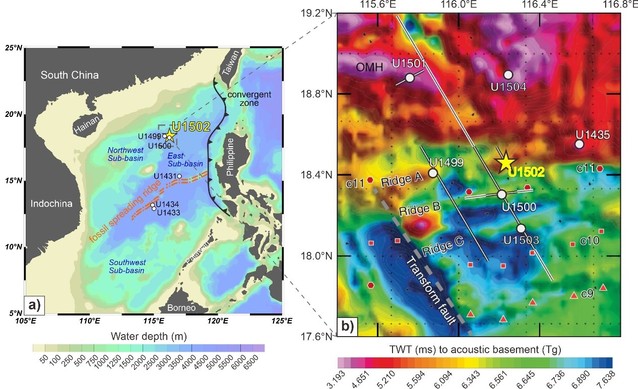Jiawang Wu *, Zhifei Liu *, Xun Yu
State Key Laboratory of Marine Geology, School of Ocean and Earth Science, Tongji University, Siping 1239, 200092 Shanghai, China
Abstract:
IODP Hole U1502B penetrates >180 m into the crystalline basement generated at a rifting margin of the South China Sea (SCS), which is the first confirmed intermediate-type margin between the magma-rich and –poor endmembers. The recovered lavas show petrographic characteristics of mid-ocean ridge basalt (MORB), but suffered pervasively from hydrothermal alteration. This sequence represents the oldest SCS oceanic crust ever drilled in-situ, and offers a globally unique window to explore the hydrothermal processes during continental breakup. Here, 50 whole-rock samples representative of Hole U1502B were analyzed for major and trace elements and Sr-Nd isotopes, presenting the first report of hydrothermally altered basalts for the SCS. The protolith appears to be tholeiite, enriched MORB, and little affected by crustal contamination due to the constant mantlevalues of εNd. However, the altered rocks are characterized by significant Ca depletion and 87Sr/86Sr modification. Major processes are identified to be tightly involved with plagioclase: chloritization and albitization. Both reactions are responsible for the Ca-loss and Sr-mobility, and for the resultant Mg- and Na-uptakes, respectively. Environments varying from the peripheral to the deep parts within a discharge zone are evidenced by the coexistence of hydro-fracturing brecciation, enrichments of base metals (Zn, Cu), high water/rock ratios (~1–25), and lower greenschist facies alteration (albite + chlorite + epidote ± quartz ± pyrite). This variability can be attributed to detachment-related faulting, allowing deeply channeled pathways of fluids. Besides, such tectonic effects permit a penetration of Hole U1502B into the porosity boundary of seismic layer 2A/2B, corresponding to either 1) the lithologic lava–dike transition and/or 2) an alteration front of hydrothermal circulation. In any case(s), our results imply a more complex and longer SCS rifting than previously thought.
Full Article:![]() Jiawang Wu, et al..pdf
Jiawang Wu, et al..pdf


